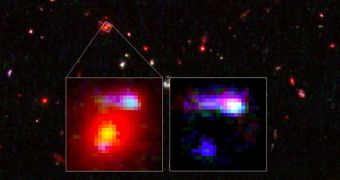Just yesterday, researchers with the Space Telescope Science Institute in the US announced the discovery of a previously unknown distant galaxy that they say acts like a cosmic magnifying glass.
As detailed in a paper in The Astrophysical Journal Letters, the galaxy in question is one of the brightest members of a cluster dubbed IRC 0218, and was discovered with the help of NASA's Hubble Space Telescope.
In a press release documenting this find, Space Telescope Science Institute researchers explain that galaxies that act like cosmic magnifying glass are known to the scientific community as lensing galaxies.
Such galaxies are so massive that their gravity toys with light originating from objects behind them. Specifically, they have been shown to bend, magnify, and distort this light, the scientists go on to explain.
The newly discovered elliptical lensing galaxy in the IRC 0218 cluster sits right in front of a fairly small spiral galaxy located 10.7 billion light-years from Earth. It is this spiral galaxy's light that the distant lensing galaxy toys with.
Astronomers say that, according to evidence at hand, this recently found cosmic magnifying glass, pictured in the image next to this article as it looked roughly 9.6 billion years ago, has a mass about 180 billion times greater than that our Sun.
This might sound like much, but, as it turns out, our home galaxy, the Milky Way, is actually about three to four times more massive. Besides, this distant lensing galaxy appears to pack very little dark matter, at least when compared to others of its kind.
“The unusually small amount of dark matter in this massive, elliptical, lensing galaxy is very surprising. Other elliptical galaxies that are closer to us have much more dark matter and have inventories of stars that appear to be different from this super-distant lensing galaxy,” said researcher Sherry Suyu.
Then again, it looks like, over the following 9 billion years, this lensing galaxy will get significantly plumper by feeding on neighboring galaxies. In fact, it is believed that it will end up having more dark matter and being considerably more massive than the Milky Way.
Interestingly enough, this distant lensing galaxy is said to be the farthest galaxy of this kind to have until now been documented by science. Commenting on this discovery, researcher Kenneth Wong pointed out that “To find a lens as far away as this one is a very special discovery because we can learn about the dark-matter content of galaxies in the distant past.”

 14 DAY TRIAL //
14 DAY TRIAL //